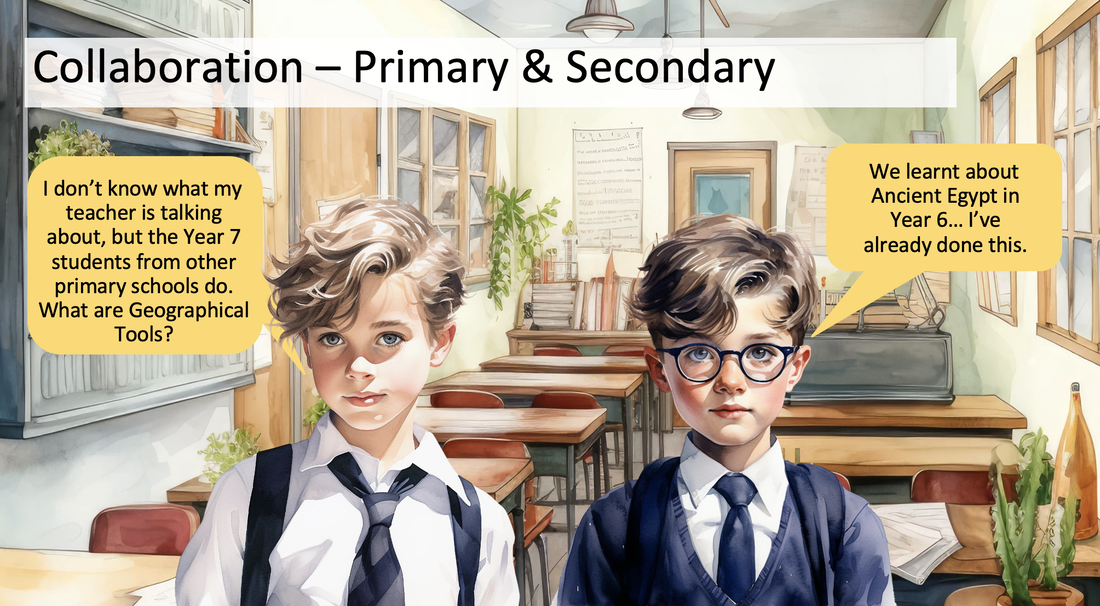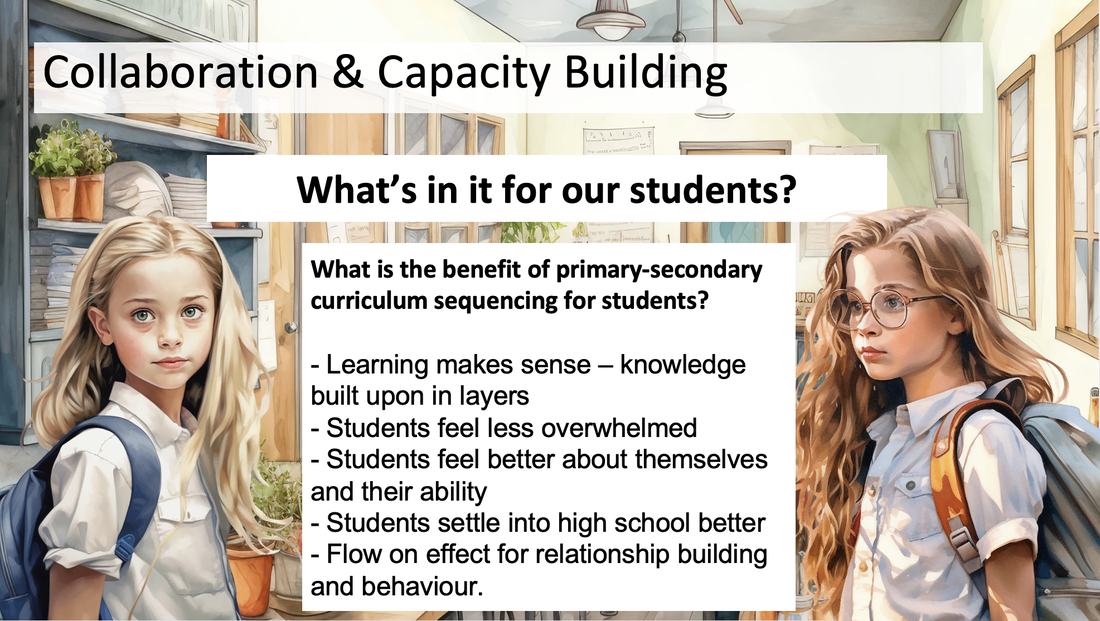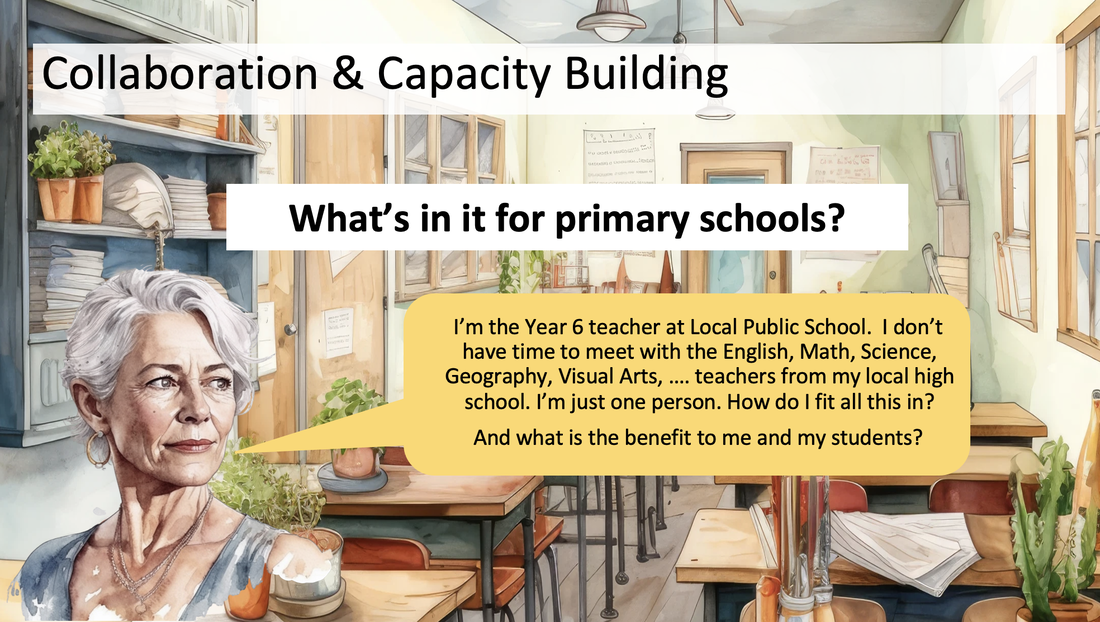|
Primary to High School transition ensures that students feel supported and settle into high school well. Most schools have comprehensive transition programs to meet the social and emotional needs of students, but with curriculum reform upon us, it may be time to revisit primary and secondary connections and collaboration in terms of curriculum sequencing and programming. Why is Primary-Secondary curriculum sequencing important? Repetition of content In HSIE subjects, a common issue that arises is that students from partner primary schools may have already completed case studies that are covered in Year 7. For example in History, students have often already learnt about Ancient Egypt. Gaps in learning Identifying any content that may have been missed by individual students or groups of students is necessary to ensure that students have the assumed knowledge that forms a basis of their learning in Year 7. For example Geography was introduced as a separate subject in primary schools as part of the K-10 Geography syllabus in 2015, rather than being part of a HSIE syllabus. As this was a more complex syllabus for K-6 Geography it was common for there to be gaps in learning when students came into Year 7. Geography has again been incorporated into a HSIE syllabus as part of the current Curriculum Reform. Complexity of learning Part of the challenge when students come into Year 7 is providing work that is complex enough for them to be engaged and interested, but providing the right supports and scaffolds to ensure they manage with all the changes that high school brings - multiple subjects and teachers, assessment tasks, a much more varied schedule, independently looking after books and laptops, etc. It is possible for students to be overwhelmed with the new setting, but bored with the content. In an attempt to ease issues with 6-7 transition, often work provided in Year 7 is too simple and doesn't challenge students enough. Primary–Secondary curriculum sequencing provides an opportunity for discussion and collaboration to address some of these issues. Primary Implementation Timeline: 2023 – English & Maths Early Stage 1 and Stage 1 implemented 2024 – English & Maths Stage 2 & 3 implemented 2027 – Creative Arts, HSIE, PDHPE, Science and Technology K-6 implemented. Secondary 7-10 Implementation Timeline: 2024 – English and Maths, Aboriginal, Classical and Modern Languages, Computing Technology implemented 2026 – Science, Dance, Drama, Music, Technology 7-8, Auslan implemented 2027 – PDHPE, Geography, History, Aboriginal Studies, Commerce, Visual Arts, Agricultural Tech, Engineering Tech, Marine and Aquaculture Tech implemented 2028 – Photographic Media, Child Studies, PASS, Visual and Motion Design, Work Education, Geography Elective, History Elective Industrial Tech, Design and Tech, Food Tech, Textiles Tech, Graphics Tech implemented Opportunities for collaboration English/Maths Both Primary & Secondary 7-10 are currently implementing the new syllabuses with programs and teaching and learning materials being developed. This provides an opportunity at the end of 2024 or beginning of 2025 for English/Maths Primary/Secondary collaboration and program review. Science, Dance, Drama, Music, Technology 7-8, Auslan Secondary 7-10 syllabuses for these subjects will be implemented in 2026. Primary schools will be implementing new syllabuses for these subjects in 2027. 2026 will provide an opportunity for high schools to provide feedback to primary schools about what's in their teaching and learning programs to inform program development in Stage 3. All other 7-10 subjects, including Geography and History Primary schools will be implementing syllabuses for Creative Arts, HSIE, PDHPE, Science and Technology K-6 in 2027. All remaining 7-10 syllabuses will be implemented in 2027 or 2028. This provides and opportunity for genuine collaborative sequencing and program development in 2025/6 for these subjects as syllabuses are finalised. Why is collaboration important between high schools and primary schools? - Curriculum sequencing – flow of content/skills, particularly in the period Year 6-7 - Avoiding repetition of concepts/case studies - Ensuring academic rigour and challenge for students (not dumbing down Year 7) - Recognising differences in delivery between primary schools and determining how to address the differences. - Sharing curriculum adjustments implemented at primary schools. What challenges does this present? How can these be overcome?
As always, the biggest issues are time and motivation. This is particularly the case for primary school teachers, who can't be expected to meet with a whole range of different specialist teachers individually. Structures need to be put in place that enable genuine sharing without placing any an reasonable burdens on teachers, but particularly primary school teachers. The use of staff development days or faculty planning time can be useful, but release time is key for initiatives like this to work. Even then, the reality is that teachers will still need to give up some time. For this reason, for the most part, initiatives like this should be done in short bursts, with small achievable objectives to be met. It takes time to build relationships between people in different schools, and as a result it can be valuable to have some key contacts at each school that work together regularly, that then bring in a larger number of staff to work together at various times. Staff turnover is another challenge to the longevity of primary-secondary collaboration initiatives. In this case, a project of a few weeks should enable schools to achieve collaboration on curriculum, without staff turnover being too much of an issue.
0 Comments
Your comment will be posted after it is approved.
Leave a Reply. |
Categories
All
Archives
May 2024
|



